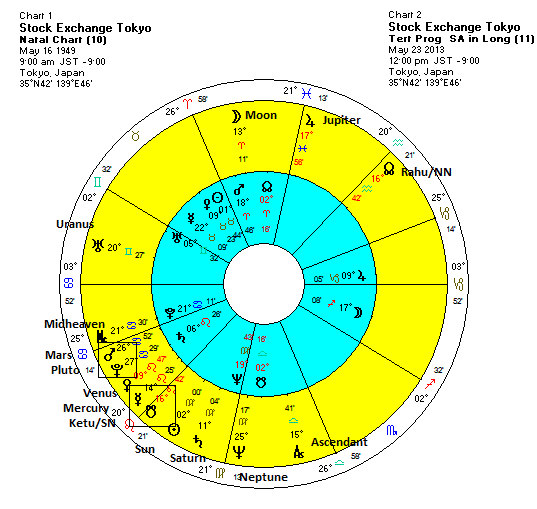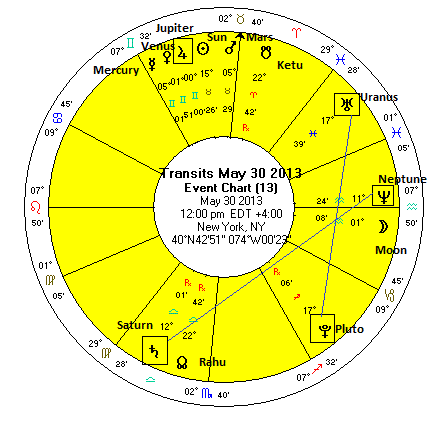 (26 May 2013)
After a parabolic rally that started in early 2013, Japanese stocks
fell back down to earth with a thud last week. Weaker than expected
industrial production data out of China was the proximate cause of the
sell-off that shaved more than 7% off the Nikkei on Thursday. Anxiety
over a possible early exit from QE3 by the Fed did not help matters
either as the Nikkei topped out at 16,000 early on Thursday before
plunging over 1000 points in a few hours. Friday's session was also
volatile as it declined further to 14,000 before recovering by the close
ending the week at 14,642.
(26 May 2013)
After a parabolic rally that started in early 2013, Japanese stocks
fell back down to earth with a thud last week. Weaker than expected
industrial production data out of China was the proximate cause of the
sell-off that shaved more than 7% off the Nikkei on Thursday. Anxiety
over a possible early exit from QE3 by the Fed did not help matters
either as the Nikkei topped out at 16,000 early on Thursday before
plunging over 1000 points in a few hours. Friday's session was also
volatile as it declined further to 14,000 before recovering by the close
ending the week at 14,642. This mini-crash nudged many global markets out of their recent complacency as the Dow finally put in a losing week after four straight weeks of gains closing at 15,303. In India, the Sensex fell 3% closing at 19,704. I thought that markets would be generally bullish for the first half of the week as the Taurus influence would predominate. This was actually largely the case as most markets rose into Wednesday. As expected, the entry of malefic Mars into Taurus on Thursday was negative so much of the decline was clustered at the end of the week.
I have previously commented on the meteoric rally in the Japanese stock market. In my weekly post for April 22, I noted that a correction would be upcoming fairly soon, perhaps starting in June once Jupiter left the friendly confines of Taurus and entered the sign of Gemini. To be sure, last week's major decline was a little ahead of schedule since Jupiter is now in the last two degrees of Taurus. Not enough for an exact hit, but perhaps close enough to be called "interesting".

From the transit chart for last Thursday, we can see a few telling patterns that may have strongly indicated an imminent decline in the market. Although not yet in Gemini, Jupiter was nonetheless under the influence of malefic Ketu within just a four degree orb. Ketu aspects are often associated with disruption of the status quo (the rally, in this case). The position of the transiting nodes is also worth noting. Transiting Ketu (22 Aries) is within four degrees of natal Mars and should be seen as broadly coincidental with difficulty and obstacles. This conjunction will be in effect for several more weeks so it will be interesting to see how that unfolds. We can also see that the nodal placement at 22 degrees of Aries/Libra does exactly align with natal Mercury at 22 Taurus. This is not a standard full-strength Vedic (120 degree) aspect but it is an exact degreewise alignment nonetheless and may have played a role in the sudden move last week. The fact that transiting Mercury and Venus were both conjunct natal Mercury may have intensified the resonance of this Rahu/Ketu alignment with Mercury.
More broadly, we can see that the Uranus-Pluto square aspect was central to this chart since Pluto was conjunct the Moon at 17 Sagittarius while Uranus was square this point. This Uranus-Pluto square is the dominant feature in the sky at the moment. While it is a slow moving aspect that will last several years due to retrogradation -- it will make its final exact aspect in 2015 -- it was nonetheless exact last week. And Pluto was just a few arc minutes away from a precise conjunction with the natal Moon in the TSE horoscope. Pluto is typically a more malefic influence, especially if it is involved with another planet in hard aspect (45/90/180) as is the case here with Uranus.

Tertiary progressions provide another dimension of explanation to last week's decline. Progressions are a standard technique in Western astrology that are often useful for identifying larger time windows when events are more likely to occur. The planetary positions in the tertiary progressed chart are usually slower than most transits. The progressed chart for the mini-crash shows that there was an ominous conjunction of Mars and Pluto -- two very malefic planets. Pluto barely moves at all when progressed, while Mars moves about one degree every two months of clock time. This conjunction was quite close last week and will actually tighten over the coming weeks. This doesn't necessarily mean that Japanese stocks will fall further, but it does increase the probability of more trouble ahead.
We can also see that Mercury was in a close conjunction with Ketu. This is another classic negative pairing. Tertiary progressed Ketu only moves a few minutes a month, while Mercury usually travels about one degree for every month of clock time. Like the Mars-Pluto conjunction, this one will also get closer in the coming weeks. Again, it doesn't mean that more downside is certain since progressions work according to more approximate parameters. But it should give bullish investors some pause since these troublesome planetary influences are probably not going to suddenly disappear.
The prevailing market opinion is that the correction was to be expected given the huge rally since the beginning of the year. Most observers do not expect the rally in Japanese stocks to end any time soon. Some analysts are saying that more "volatility" is possible in the near future. Volatility is a euphemism for declines, of course, and I would tend to agree with that view in the near term. In other words, I don't think this correction is done. It will be interesting to see what happens after Jupiter enters Gemini on the 30th and comes under continued influence by natal Ketu in early June.

This week offers up not one but two conjunctions involving bullish Jupiter. And both conjunctions involve bullish planets -- Mercury and Venus. Moreover, all three planets are slated to change signs as they all leave Taurus and enter Gemini during the week. All in all, these are some pretty positive factors that argues fairly strongly for gains this week. That said, it is worth noting that these bullish conjunctions can sometimes mark sudden shifts in sentiment as soon as they become exact, as when a balloon bursts. The entry of Jupiter into Gemini on Thursday also looks particularly favourable for most asset classes. But one will have to pay close attention to the immediate aftermath of these sign changes and culminated aspects. The ongoing tight Uranus-Pluto square aspect is an additional source of potential difficulty in the days and weeks to come. This aspect formed an exact aspect on May 21st, just a day or two before the Bernanke-led global pullback and Japanese mini-crash.



